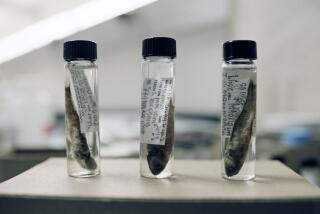Fertility Study Finds DDTâs Legacy
Women who were exposed while still in the womb to the pesticide DDT are more likely to experience delays in getting pregnant, according to a study of California mothers and daughters published today in an international medical journal.
The report by the Public Health Institute in Berkeley is the first scientific evidence that DDT that collects in womenâs bodies can affect their female offspring many years later, when they reach adulthood and attempt to reproduce.
The findings support a controversial theory that pesticides and other environmental contaminants that mimic sex hormones are altering human fertility and health.
DDT was used worldwide in the 1940s through 1960s for pest control. Banned in the United States and most of the world, it is still used in parts of Africa, Southeast Asia, South America and Latin America to control malaria-carrying mosquitoes. Many Americans still have the pesticide and its byproducts in their bodies, and they continue to be exposed through produce grown in tropical countries, as well as fish caught in some U.S. waters, particularly in the Los Angeles area.
The Berkeley team measured the pesticide in stored blood that had been drawn between 1960 and 1963 from new mothers in the Oakland area. Then the researchers questioned the daughters of those women to calculate how long it had taken them to conceive.
On the basis of responses from 289 women, the scientists found that the length of time it took for the women to get pregnant correlated strongly with the amount of DDT in their motherâs blood, according to the study, which was published in the British journal Lancet.
To their surprise, the scientists also found that a common breakdown product of DDT seemed to have the exact opposite effect: The more DDE in the mothers, the less time it took for the daughters to become pregnant.
Scientists say that the unexpected, mixed results of the new study show that hormone-disrupting chemicals work in a complicated way on human bodies that no one yet understands. The results indicate that a womanâs fertility can be altered in sometimes inexplicable ways by what her mother was exposed to decades earlier.
âThis raises the specter that the chemical cocktail we are all exposed to is altering our human reproductive capability,â said the studyâs lead researcher, Barbara Cohn, director of the Center for Research on Womenâs and Childrenâs Health at the Public Health Institute, which is one of the largest nonprofit public health agencies in the country.
The study found that, after 13 months of trying, about 75% of all the women in the study were pregnant. But for the group with higher than median DDT and lower DDE, only 65% were pregnant. For the group with higher than median DDE and lower DDT, 83% were pregnant.
âWhile it is reassuring that possible harmful effects of DDT may be reduced by its conversion to DDE, women still experienced delays in becoming pregnant,â Cohn said.
The apparent counteractive effect of DDE could explain why there have been no reported widespread fertility problems in the generation of women exposed in the womb to the pesticide. DDT converts slowly into its metabolite DDE in the body and in the environment.
In the U.S., children born between the late 1950s and the late 1960s probably had the highest exposures to the pesticide of any generation. People are exposed to the compounds, which can last for decades in soil or at the bottoms of oceans and rivers, mainly through food. The chemicals are stored in a womanâs fat over her lifetime and cross into the placenta during pregnancy, exposing the fetus.
âThe real message of our study is that the human system is vulnerable to these chemicals,â Cohn said.
For every increase of 10 parts per billion of DDT in the motherâs blood, the daughterâs probability of pregnancy within a cycle fell 32%. But for every 10-ppb increase in DDE, the probability of pregnancy increased 16%.
âThe conclusions are conflicting. We just donât have a way of understanding it, â said Dr. Harry Fisch, a fertility expert at Columbia Presbyterian Medical Center in New York who was not involved with the research.
Cohn suspects that an explanation lies in the differing hormone-disrupting abilities of the two compounds. DDE is a potent blocker of male hormones called androgens; DDT mimics estrogen. Perhaps blocking androgens in some women increases their fertility and offsets the effect of the DDT.
Dr. Robert Taylor, director of the Center for Reproductive Sciences at University of California, San Francisco, called the study quite remarkable because it involves mothers and daughters. He said the good news is that the body seems capable of changing DDT to a form that does not harm offspring. âThis suggests that we were fortunate to have evolved in a way that lets us dodge some of these potentially toxic bullets,â he said.
The researchers warned in their report that, although they adjusted their data for several factors that affect fertility, such as age, frequency of intercourse and alcohol use, âother factors could confound our findings.â
Most scientists agree that many pesticides and industrial chemicals mimic the effects of estrogen or block testosterone. Studies of lab animals and wildlife have already linked many chemicals, including DDT and its metabolites, to infertility, birth defects and other reproductive problems. But there has been little information about humans.
Another study recently reported that men exposed to pesticides have as much as a 30-fold reduction in sperm quality.






